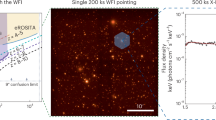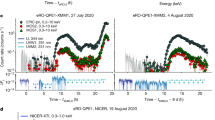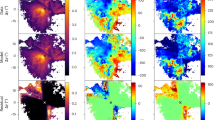Abstract
De Rújula and Glashow1 have suggested that nuclearites, aggregates of up, down and strange quarks in roughly equal proportions, may form a component of the material reaching the Earth from the Galaxy. On traversing the atmosphere they will look something like meteors, but will travel faster. The masses of these aggregates may vary over a wide range and their velocities will be typically 250 km s−1, corresponding to the Sun's galactic rotation. If all the dark matter in the Galaxy is assumed to be in the form of nuclearites, a limit can be set to the incoming flux. We report here upper limits derived from four experiments, originally carried out to detect cosmic γ rays, as well as some derived by other authors, which would be sensitive to pulses of light from nuclearites in the lower atmosphere. Our upper limits are compatible with the suggested maximum flux and competitive with a search for tracks etched in mica2, which could also be caused by nuclearites.
This is a preview of subscription content, access via your institution
Access options
Subscribe to this journal
Receive 51 print issues and online access
$199.00 per year
only $3.90 per issue
Buy this article
- Purchase on SpringerLink
- Instant access to full article PDF
Prices may be subject to local taxes which are calculated during checkout
Similar content being viewed by others
References
De Rújula, A. & Glashow, S. L. Nature 312, 734–737 (1984).
Price, P. B. et al. Phys. Rev. Lett. 52, 1265–1268 (1984).
Helmken, H. F. et al. Astrophys. J. 184, 245–250 (1973).
Porter, N. A. & Weekes, T. C. Nature 277, 199 (1979).
Jelley, J. V. Cerenkov Radiation, 219 (Pergamon, London, 1958).
Allen, C. W. Astrophysical Quantities 190 (University of London Press, 1964).
Porter, N. A., Delaney, T., Helmken, H. F. & Weekes, T. C. Nuovo Cimento 32B, 514–518 (1976).
Porter, N. A. & Weekes, T. C. Astrophys. J. 212, 224–226 (1977).
Porter, N. A. et al. Nature 304, 606–607 (1983).
Cook, A. F., Weekes, T. C., Williams, J. T. & O'Mongain, E. Mon. Not. R. astr. Soc. 193, 645–666 (1980).
Charman, W. N. & Jelley, J. V. J. Phys. A5, 773–780 (1972).
Byrne, P., & Wayman, P. A. Mon. Not. R. astr. Soc. 173, 537–552 (1975).
Baird, G. A., Delaney, T. J. & Lawless, B. G. Observatory 92, 233–234 (1972).
Ogelman, H. J geophys. Res. 78, 3033–3039 (1973).
Author information
Authors and Affiliations
Rights and permissions
About this article
Cite this article
Porter, N., Fegan, D., MacNeill, G. et al. A search for evidence of nuclearites in astrophysical pulse experiments. Nature 316, 49 (1985). https://doi.org/10.1038/316049a0
Received:
Accepted:
Issue date:
DOI: https://doi.org/10.1038/316049a0
This article is cited by
-
Magnetised quark nuggets in the atmosphere
Scientific Reports (2021)
-
Mass distribution of magnetized quark-nugget dark matter and comparison with requirements and observations
Scientific Reports (2020)
-
Radio frequency emissions from dark-matter-candidate magnetized quark nuggets interacting with matter
Scientific Reports (2020)
-
Detection of magnetized quark-nuggets, a candidate for dark matter
Scientific Reports (2017)
-
Search for strange matter by Rutherford backscattering
Nature (1989)



